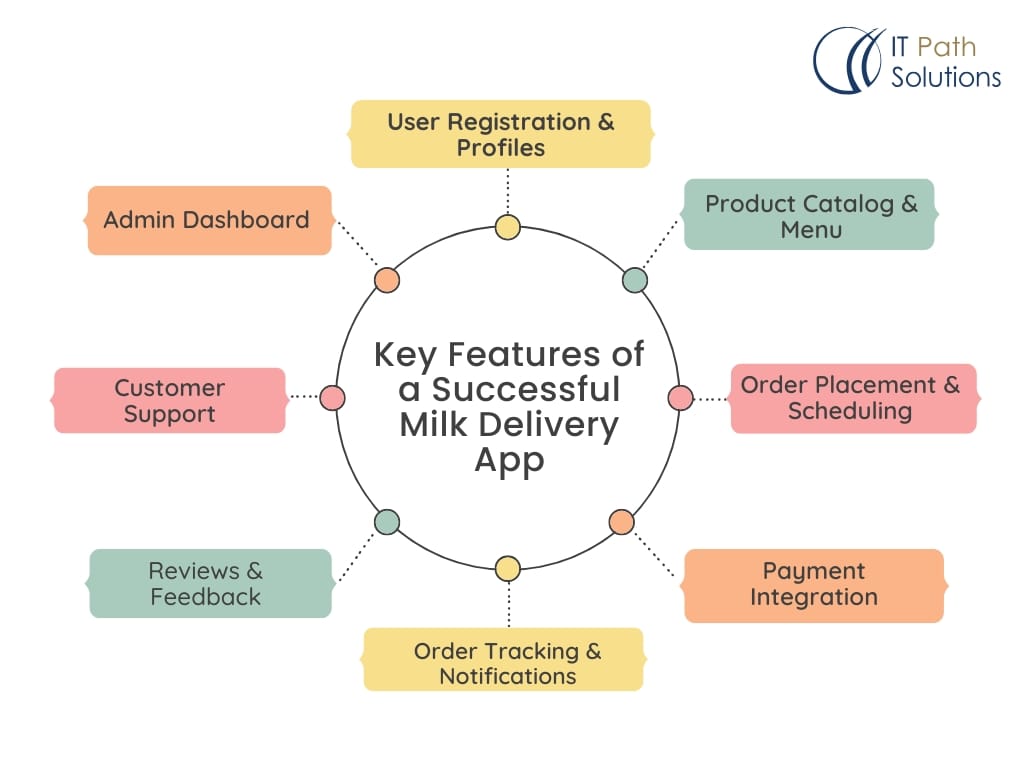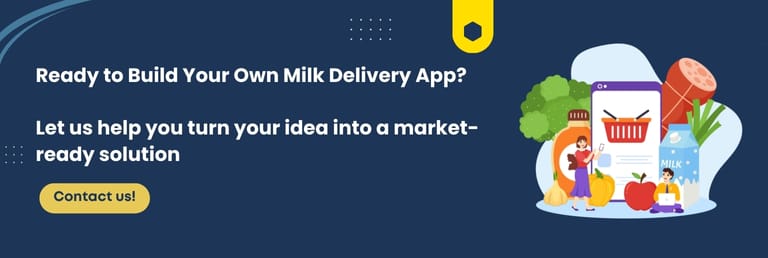Milk Delivery App Development : A Complete Guide
Keyur Patel
September 12, 2025
7 min
The success of brands like Milk Basket and Country Delight shows that customers value on-demand, reliable services—even when it comes to milk. This comprehensive guide will walk you through everything you need to know about milk delivery app development, from concept to launch, ensuring your mobile app for milk delivery stands out in a competitive market app
Introduction
The milk delivery industry is evolving rapidly with digital transformation. Traditional milk delivery has made way for innovative milk delivery app solutions that ensure freshness, convenience, and reliability. Whether you are a dairy entrepreneur or a tech startup, developing a mobile app for milk delivery can revolutionize the way customers access daily essentials.
In this guide, we dive deep into milk delivery app development, covering best practices, technology choices, and strategies to build an engaging and scalable app—one that can compete with the likes of Milk Basket and Country Delight.
Understanding the Market
Market Trends
The demand for digital services in the dairy sector is rising. Consumers now expect:
- Convenience: Order fresh milk and dairy products from the comfort of their homes.
- Real-Time Tracking: Monitor delivery status and ensure timely receipt.
- Subscription Options: Regular deliveries tailored to customer schedules.
Market research indicates that the dairy industry is ripe for digital disruption, making it an ideal time to invest in a milk delivery app solution.
Consumer Expectations
Customers value:
- Freshness & Quality: Assurance of high-quality dairy products.
- User-Friendly Interface: Seamless ordering experience.
- Personalization: Customizable subscriptions and offers.
- Customer Support: Quick resolution of issues through in-app chat or call.
Understanding these trends and preferences is crucial in shaping your app’s features and overall strategy.
Key Features of a Successful Milk Delivery App
For your mobile app for milk delivery to be competitive, it should include the following essential features:

1. User Registration & Profiles
- Secure Login: Social media, email, or phone number-based authentication.
- Personalization: Allow users to set preferences, dietary requirements, and delivery schedules.
2. Product Catalog & Menu
- Comprehensive Listings: Fresh milk, butter, cheese, and other dairy products.
- Detailed Descriptions: Nutritional information, sourcing details, and pricing.
3. Order Placement & Scheduling
- Flexible Scheduling: Options for daily, weekly, or subscription-based orders.
- Real-Time Availability: Display current stock and estimated delivery times.
4. Payment Integration
- Multiple Payment Options: Credit/debit cards, digital wallets, and UPI.
- Secure Payment Gateway: Ensure data encryption and secure transactions.
5. Order Tracking & Notifications
- Real-Time Tracking: GPS integration for live updates.
- Push Notifications: Inform users about order status, delivery updates, and promotional offers.
6. Reviews & Feedback
- User Ratings: Collect reviews and ratings for quality assurance.
- Feedback System: Enable customers to suggest improvements.
7. Customer Support
- In-App Chat & Call: Direct communication for prompt issue resolution.
- FAQ & Help Center: Comprehensive support resources.
8. Admin Dashboard
- Order Management: Track orders, manage inventory, and oversee deliveries.
- Analytics & Reporting: Monitor performance metrics and user behavior.
Incorporating these features is vital to building a robust milk delivery app solution that meets customer needs and drives engagement.
The Development Process
1. Planning & Research
- Market Analysis: Study competitors like Milk Basket and Country Delight to identify gaps and opportunities.
- Define Objectives: Outline the core goals of your mobile app for milk delivery.
- Target Audience: Identify demographics, geographic areas, and customer preferences.
2. Designing the User Experience
- Wireframing: Create initial layouts and design prototypes.
- UI/UX Design: Focus on creating an intuitive, visually appealing interface that enhances user experience.
3. Development & Testing
- Agile Development: Use iterative development processes to build, test, and refine your app.
- Quality Assurance: Perform rigorous testing to ensure smooth performance, secure transactions, and bug-free operations.
- Beta Testing: Gather feedback from a limited user base to fine-tune features before launch.
4. Deployment
- App Stores: Prepare for launch on Apple App Store and Google Play Store.
- Monitoring & Maintenance: Post-launch, continuously monitor app performance and user feedback for improvements.
Technology Stack & Infrastructure
When it comes to milk delivery app development, selecting the right technology is crucial for scalability and performance.
Frontend Development
- Frameworks: React Native or Flutter for cross-platform mobile app development.
- UI Libraries: Use Material Design or custom design systems for a modern look.
Backend Development
- Server: Node.js, Ruby on Rails, or Python for a robust backend.
- Database: MySQL or MongoDB for handling user data and orders.
- APIs: RESTful or GraphQL APIs to integrate various services like payment gateways and tracking systems.
Cloud Infrastructure
- Hosting: AWS, Google Cloud, or Azure for reliable server hosting and scaling.
- Security: Implement SSL encryption, two-factor authentication, and secure payment protocols.
Integration Tools
- Payment Gateways: Stripe, PayPal, or Razorpay for seamless transactions.
- GPS & Mapping: Google Maps API for real-time tracking and location services.
- Push Notifications: Firebase Cloud Messaging (FCM) for timely alerts and updates.
Choosing the right tech stack will help you build a durable, scalable mobile app for milk delivery that can adapt to future demands.
Monetization & Business Models
There are several ways to generate revenue with your milk delivery app:
1. Subscription Model
Offer customers recurring delivery subscriptions with discounts or loyalty points.
2. Commission-Based Model
Earn commissions on each order processed through your app.
3. In-App Advertising
Integrate ads from related brands (e.g., organic dairy products, health supplements) to supplement your revenue.
4. Premium Features
Offer advanced features, such as personalized nutrition advice or premium delivery options, for an extra fee.
A well-thought-out monetization strategy not only ensures profitability but also enhances user retention by offering value-added services.
Marketing & User Acquisition
SEO & Content Marketing
- Keyword Strategy: Optimize your website and app descriptions for keywords like “milk delivery app development”, “mobile app for milk delivery”, and “milk delivery app solution”.
- Blog Posts & Articles: Publish engaging content about dairy industry trends, healthy living, and the benefits of your service.
Social Media & Influencer Marketing
- Engage on Platforms: Use Instagram, Facebook, and LinkedIn to share success stories and customer testimonials.
- Collaborate: Partner with local influencers and nutrition experts to boost credibility and reach.
Promotions & Referral Programs
- Discounts & Offers: Launch introductory offers to attract new customers.
- Referral Programs: Encourage satisfied customers to refer friends and family with reward incentives.
Local SEO
- Geo-Targeting: Optimize for local search terms to attract customers in your delivery areas.
- Customer Reviews: Encourage reviews on Google My Business and other local platforms to boost trust and visibility.
Case Studies: Milk Basket & Country Delight
Milk Basket
Milk Basket revolutionized the milk delivery industry by introducing a subscription-based model. Their success stems from:
- Seamless Ordering Process: Easy scheduling and modifications to orders.
- Hyperlocal Logistics: Ensuring timely deliveries using efficient route planning.
- Strong Customer Retention Strategies: Subscription discounts and personalized promotions.
Country Delight
Country Delight focuses on delivering fresh, farm-sourced milk directly to customers. Their business model stands out due to:
- Farm-to-Home Approach: Eliminating middlemen to maintain milk purity.
- AI-Driven Supply Chain: Optimizing inventory management and delivery efficiency.
- Quality Assurance: Regular lab testing and consumer feedback integration.
Conclusion
Developing a milk delivery app is a lucrative business opportunity in today’s fast-paced, convenience-driven world. By integrating the right features, choosing a robust technology stack, and implementing an effective marketing strategy, you can build a successful mobile app for milk delivery that meets modern consumer demands.
If you’re ready to launch your milk delivery app, start by defining your business model, assembling the right development team, and leveraging industry best practices. With the right approach, your app can become the next big name in the dairy delivery industry!

Keyur Patel
Co-Founder
Keyur Patel is the director at IT Path Solutions, where he helps businesses develop scalable applications. With his extensive experience and visionary approach, he leads the team to create futuristic solutions. Keyur Patel has exceptional leadership skills and technical expertise in Node.js, .Net, React.js, AI/ML, and PHP frameworks. His dedication to driving digital transformation makes him an invaluable asset to the company.

